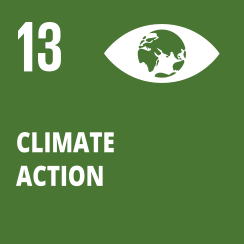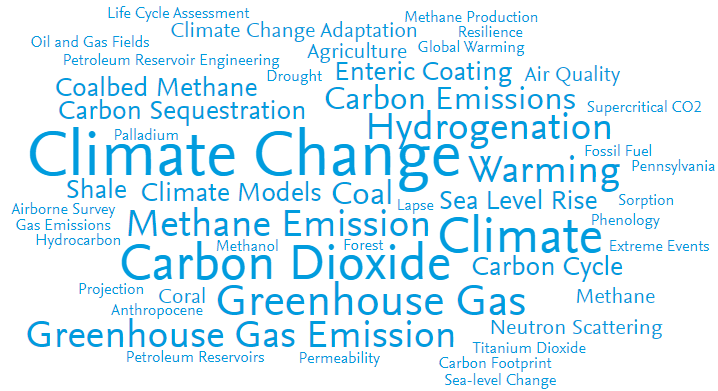
Take urgent action to combat climate change and its impacts
To reach this goal, some key targets have been outlined. They include strengthening resilience and adaptive capacity; implementing national policies, strategies and planning; improving education, awareness-raising and human and institutional capacity; addressing the needs of developing countries in the context of meaningful mitigation actions; and, raising capacity for effective climate change-related planning and management. Learn more about this goal in the Targets & Indicators section below.

Source: SciVal.com | This word cloud was created using publications from Penn State researchers
Related News
Climate-driven extreme heat may make parts of Earth too hot for humans
If global temperatures increase by 1 degree Celsius (C) or more than current levels, each year billions of people will be exposed to heat and humidity so extreme they will be unable to naturally cool [...]
Curbing cow belches in the name of climate change mitigation
A Penn State livestock emissions expert has received a grant from the Greener Cattle Initiative to develop actionable options to mitigate enteric, or intestinal, methane emissions from cattle — which are produced via belching. Alex [...]
Mussels inspire an eco-friendly way to extract critical rare earth elements
There is a conundrum around rare earth elements (REE). They play a key role in clean energy, vital to the production of lightweight, efficient batteries and essential components in wind turbines. Conversely, conventional extraction of [...]
New glass cuts carbon footprint by nearly half and is 10x more damage resistant
Worldwide, glass manufacturing produces at least 86 million tons of carbon dioxide every year. A new type of glass promises to cut this carbon footprint in half. The invention, called LionGlass and engineered by researchers at Penn [...]
Carbon voyage: $2 million grant enables study of shipboard carbon capture and alternative fuel utilization
The Navy Decarbonization Research Consortium is a public-private collaboration that aims to advance interdisciplinary research to help the U.S. Navy meet the complex challenges of platform decarbonization, with a focus on ships and aircraft, according to the consortium [...]
Microbe-stuffed soil crusts menaced by climate change
Using a novel method to detect microbial activity in biological soil crusts, or biocrusts, after they are wetted, a Penn State-led research team in a new study uncovered clues that will lead to a better [...]
Targets & Indicators
Target 13.1: Strengthen resilience and adaptive capacity to climate-related hazards and natural disasters in all countries
- Indicator 13.1.1: Number of deaths, missing persons and directly affected persons attributed to disasters per 100,000 population
- Indicator 13.1.2: Number of countries that adopt and implement national disaster risk reduction strategies in line with the Sendai Framework for Disaster Risk Reduction 2015–2030
- Indicator 13.1.3: Proportion of local governments that adopt and implement local disaster risk reduction strategies in line with national disaster risk reduction strategies
Target 13.2: Integrate climate change measures into national policies, strategies and planning
- Indicator 13.2.1: Number of countries with nationally determined contributions, long-term strategies, national adaptation plans and adaptation communications, as reported to the secretariat of the United Nations Framework Convention on Climate Change
- Indicator 13.2.2: Total greenhouse gas emissions per year
Target 13.3: Improve education, awareness-raising and human and institutional capacity on climate change mitigation, adaptation, impact reduction and early warning
- Indicator 13.3.1: Extent to which (i) global citizenship education and (ii) education for sustainable development are mainstreamed in (a) national education policies; (b) curricula; (c) teacher education; and (d) student assessment
Target 13.a: Implement the commitment undertaken by developed-country parties to the United Nations Framework Convention on Climate Change to a goal of mobilizing jointly $100 billion annually by 2020 from all sources to address the needs of developing countries in the context of meaningful mitigation actions and transparency on implementation and fully operationalize the Green Climate Fund through its capitalization as soon as possible
- Indicator 13.a.1: Amounts provided and mobilized in United States dollars per year in relation to the continued existing collective mobilization goal of the $100 billion commitment through to 2025
Target 13.b: Promote mechanisms for raising capacity for effective climate change-related planning and management in least developed countries and small island developing States, including focusing on women, youth and local and marginalized communities
- Indicator 13.b.1: Number of least developed countries and small island developing States with nationally determined contributions, long-term strategies, national adaptation plans and adaptation communications, as reported to the secretariat of the United Nations Framework Convention on Climate Change






